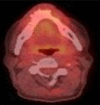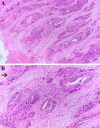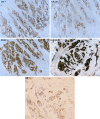Primary Intestinal-Type Adenocarcinoma of Tongue: A Case Report with Immunohistochemical and Molecular Profiles and Review of the Literature
- PMID: 27752836
- PMCID: PMC5429281
- DOI: 10.1007/s12105-016-0759-9
Primary Intestinal-Type Adenocarcinoma of Tongue: A Case Report with Immunohistochemical and Molecular Profiles and Review of the Literature
Abstract
Primary lingual intestinal-type adenocarcinomas are extremely rare with only a few cases described. A case with immunohistochemical expression of Androgen Receptor (AR) which was treated solely by chemo-radiotherapy is reported herein. A 54-year-old male was referred with symptoms of fullness in his tongue. Clinical examination showed an asymmetry of the tongue with a hard mass palpable within the middle of the tongue. Biopsy showed intestinal-type adenocarcinoma. The tumour showed positive staining with cytokeratin 7, cytokeratin 20, CDX2, AR, β-catenin and was mismatch repair proteins (MMR) proficient. The molecular analysis did not show mutations in the KRAS, NRAS, BRAF and PIK3CA genes. The patient was treated with radiochemotherapy and is in remission 3.5 years after the diagnosis. This is the first case of intestinal-type tongue adenocarcinoma which showed AR expression and was treated solely with radical chemoradiotherapy.
Keywords: Adenocarcinoma; Androgen receptor; Intestinal type; Salivary gland; Tongue.
Conflict of interest statement
No conflict of interest to disclose.
Figures




Similar articles
-
Primary intestinal-type adenocarcinoma of the tongue.Int J Oral Maxillofac Surg. 2018 Dec;47(12):1523-1526. doi: 10.1016/j.ijom.2018.04.009. Epub 2018 Apr 30. Int J Oral Maxillofac Surg. 2018. PMID: 29724582 Review.
-
Primary Lingual Colonic-Type Adenocarcinoma: A Rare and Emerging Distinct Entity!Head Neck Pathol. 2017 Jun;11(2):234-239. doi: 10.1007/s12105-016-0740-7. Epub 2016 Jun 29. Head Neck Pathol. 2017. PMID: 27357134 Free PMC article.
-
Primary intestinal-type adenocarcinoma of the oral tongue: Case report and review of histologic origin and oncologic management.Head Neck. 2018 Jul;40(7):E68-E72. doi: 10.1002/hed.25203. Epub 2018 May 13. Head Neck. 2018. PMID: 29756292 Review.
-
Colonic-type adenocarcinoma of the base of the tongue: a case report of a rare neoplasm.Head Neck Pathol. 2012 Jun;6(2):250-4. doi: 10.1007/s12105-011-0301-z. Epub 2011 Sep 25. Head Neck Pathol. 2012. PMID: 21948243 Free PMC article.
-
Mixed adenoneuroendocrine carcinoma of the tongue arising within a congenital enteric cyst.Head Neck. 2018 May;40(5):E53-E57. doi: 10.1002/hed.25117. Epub 2018 Feb 23. Head Neck. 2018. PMID: 29473257
Cited by
-
Response to "Colonic-Type Adenocarcinoma of the Tongue and Oral Cavity (CATOC)".Head Neck Pathol. 2018 Jun;12(2):294-295. doi: 10.1007/s12105-017-0865-3. Epub 2017 Nov 11. Head Neck Pathol. 2018. PMID: 29128950 Free PMC article. No abstract available.
-
Imaging Findings of Adenocarcinoma Arising from Lingual Foregut Duplication Cyst.J Belg Soc Radiol. 2023 Aug 25;107(1):62. doi: 10.5334/jbsr.3156. eCollection 2023. J Belg Soc Radiol. 2023. PMID: 37635745 Free PMC article.
-
Colonic-type Adenocarcinoma of the Tongue and Oral Cavity (CATOC).Head Neck Pathol. 2018 Jun;12(2):291-293. doi: 10.1007/s12105-017-0843-9. Epub 2017 Aug 4. Head Neck Pathol. 2018. PMID: 28779466 Free PMC article. No abstract available.
-
Tubulovillous adenoma with high-grade dysplasia of the vulva harboring high tumor mutational burden and cancer-associated mutations: a case report.Diagn Pathol. 2022 Oct 28;17(1):85. doi: 10.1186/s13000-022-01268-7. Diagn Pathol. 2022. PMID: 36307835 Free PMC article.
-
Androgen Receptor Expression in Primary Nonsquamous Cell Rare-Variant Carcinomas of the Head and Neck.OTO Open. 2017 Jun 15;1(2):2473974X17715633. doi: 10.1177/2473974X17715633. eCollection 2017 Apr-Jun. OTO Open. 2017. PMID: 30480186 Free PMC article.
References
Publication types
MeSH terms
Substances
LinkOut - more resources
Full Text Sources
Other Literature Sources
Research Materials
Miscellaneous

